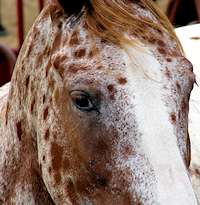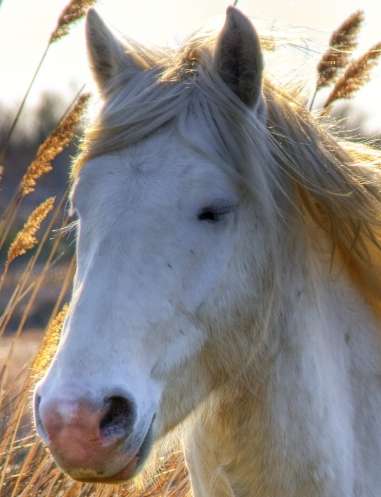A horse with a pig eye has a small eye, primarily an aesthetic issue, but claimed by some to be linked to stubbornness or nervousness. There is actually some truth to this.
 In general, there are four types of disposition in horses.The first is the horse with the big soft eye. This horse will also be broad between the eyes and have plenty of room from the eyes to the top of the poll. He will have nicely formed ears that will be wide apart and project from the head at an angle and never vertically. Horses with these characteristics are usually receptive to discipline and easy to train.
In general, there are four types of disposition in horses.The first is the horse with the big soft eye. This horse will also be broad between the eyes and have plenty of room from the eyes to the top of the poll. He will have nicely formed ears that will be wide apart and project from the head at an angle and never vertically. Horses with these characteristics are usually receptive to discipline and easy to train.
Type number two is very distinct because of the eye placement. Number two’s eye projects forward and further sideways than most horses, allowing it to see both before and behind simultaneously. The eyes will be quite big and will have a staring frightened look in them. This horse will be very quick to act and will go all out when it does. Unlike number three who balks at everything, this horse will want to do everything himself very quickly. Even though it will resist hard initially, it will surrender unconditionally when conquered.
Type number three is the pig-eyed horse with a bulge between the eyes. Usually his eyes are small and he comes with a heavy jowl, Roman nose, and thick throatlatch. These horses can be difficult to train because they tend to be very stubborn. This is the sullen horse we all dread.

Type number four has a very prominent forehead, small pig eyes, and a dished face. This horse reacts without cause and when you aren’t expecting it. He is the calculating type that will act nice once or twice just to get you later.
There is actually a scientific explanation for this analysis.
Most people think that a pig eye means the horse’s eye is smaller, but in actuality it’s the eye socket that is smaller. The size of the horse’s eyeball doesn’t change, just the skeletal structure surrounding it, dictating how much of the eye you see. It is thought that this limits the animal’s peripheral vision, which makes him more likely to be flighty or to bolt with very little provocation.
